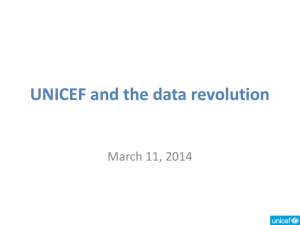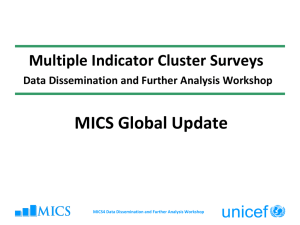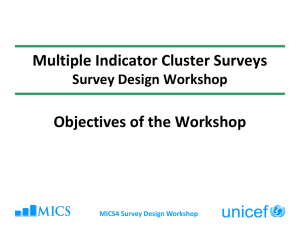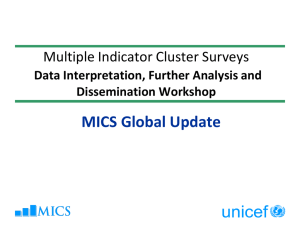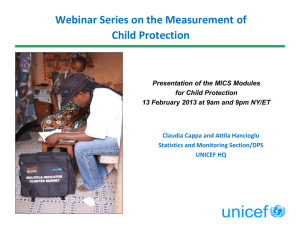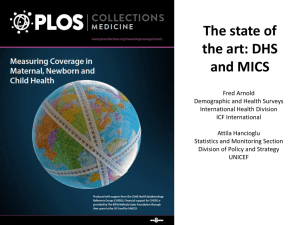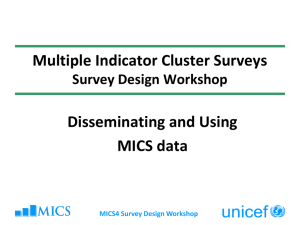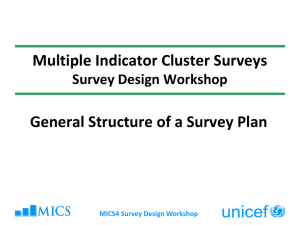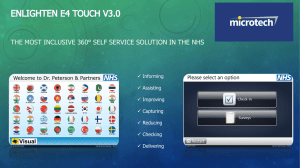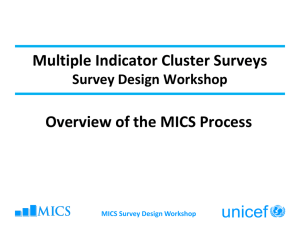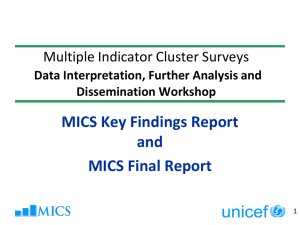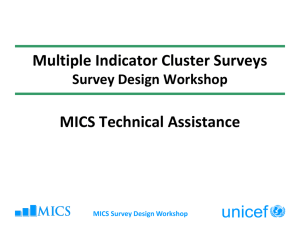Multiple Indicator Cluster Surveys (MICS)
advertisement
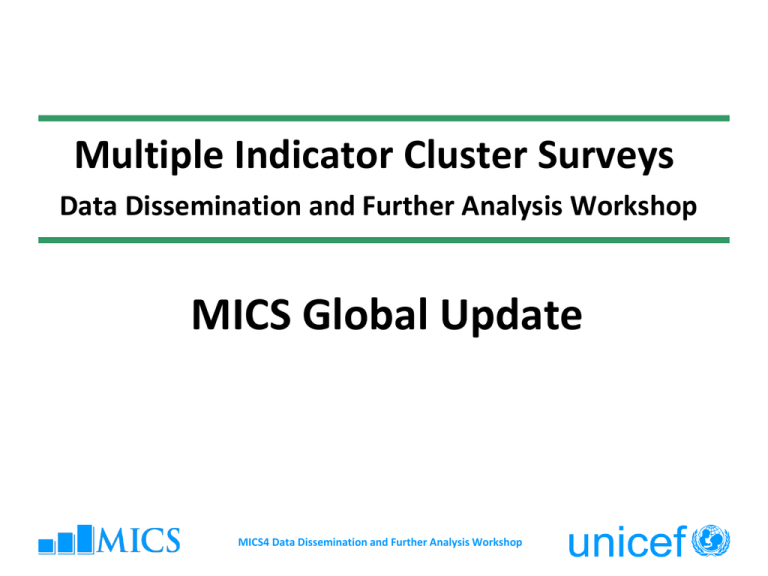
Multiple Indicator Cluster Surveys Data Dissemination and Further Analysis Workshop MICS Global Update MICS4 Data Dissemination and Further Analysis Workshop Global household survey programmes • Since 1970s • Multi-topic, multiple indicator surveys • World Fertility Surveys (1970s, early 1980s) • Contraceptive Prevalence Surveys (1980s) • Demographic and Health Surveys (since 1980s, USAID) • Multiple Indicator Cluster Surveys (since 1995, UNICEF) • Reproductive Health Surveys (since 1990s, CDC) Global household survey programmes • Thematic surveys • Living Standards Measurement Surveys - LSMS (World Bank) • Malaria Indicator Surveys – MIS (RBM Malaria) • AIDS Indicator Surveys - AIS (USAID) • SMART surveys (Nutrition) Multiple Indicator Cluster Surveys • Household survey program, developed by UNICEF in the 1990s – to assist countries in filling data gaps on children’s and women’s well-being for tracking progress toward World Summit for Children Goals • Nationally representative household sample surveys – Face to face interviews, observations, measurements – Representative sample of households Multiple Indicator Cluster Surveys (MICS) Since 1995, more than 100 countries and close to 230 surveys Notes: Countries with at least one MICS survey Including sub-national surveys and ongoing MICS4 surveys Background • MICS1 and MICS2 – 1995 and 2000 – Emphasis on World Summit for Children goals – 62 and 65 countries • MICS3 – 2005-2006 – Emphasis on World Fit for Children Goals, MDGs, and plus – 52 countries MICS4 • Launched in 2009 • Ends in 2011 • MDGs and other globally recommended indicators • 59 surveys (as of September 2011) – National: 47 surveys – Selected regions/zones: 12 surveys MICS4 Surveys by Region 14 12 12 11 10 Number of Surveys 10 9 8 6 6 6 5 4 2 0 CEECIS East Asia Pacific Eastern-Southern Africa Middle East North Africa South Asia Latin America Caribbean Western-Central Africa Status of MICS4 Surveys Completed 3 Report drafting 7 Analysis 16 Data editing 1 Data entry 1 Fieldwork Training Pre-test 6 0 2 Design Planning 12 9 Number of surveys MICS4 Countries - Global • Low and middle income countries • Emergency or post-emergency situations • New to MICS, all MICS rounds, returning countries • Single household survey data source on children in many countries • Included in statistical plans Regional Workshops • Survey Design (7) • Data Processing (6) • Data dissemination and further analysis – Interpretation of results, tables – Dissemination – Further analysis •Bangkok (EAPRO-ROSA): 23-28 May •Istanbul (Global): 24-30 June •Dakar (Africa): 19-26 July •Belgrade (Global): 13-19 November Methodological work • Completed: – – – – – – Post-natal care Early childhood development Life satisfaction Child disability medical assessment Place for hand washing Unmet need • Ongoing – – – – Child labor Vulnerability Migration PDA/Tablet use Questionnaires • Modules that were “additional/optional” or which were being developed at the time of the first workshop are now part of the core set of questionnaires • A single set of questionnaires are now being used – no additional or optional modules • • • • • • • • • • • DEMOGRAPHICS ORPHANHOOD EDUCATION WATER AND SANITATION HOUSEHOLD CHARACTERISTICS INSECTICIDE TREATED NETS INDOOR RESIDUAL SPRAYING CHILD LABOUR CHILD DISCIPLINE HANDWASHING SALT IODIZATION • • • • • • • • • • • • • • • AGE AND LITERACY ACCESS TO MASS MEDIA AND USE OF ICT CHILD MORTALITY (WITH OR WITHOUT BIRTH HISTORIES) DESIRE FOR LAST BIRTH ANTENATAL, DELIVERY, POST-NATAL CARE ILLNESS SYMPTOMS CONTRACEPTION, UNMET NEED FGM ATTITUDES TOWARD DOMESTIC VIOLENCE MARRIAGE/UNION SEXUAL BEHAVIOUR HIV/AIDS MATERNAL MORTALITY TOBACCO AND ALCOHOL USE LIFE SATISFACTION • • • • • • • • AGE BIRTH REGISTRATION PRE-SCHOOL ATTENDANCE, EARLY CHILDHOOD DEVELOPMENT BREASTFEEDING, INFANT AND YOUNG CHILD FEEDING CARE OF ILLNESS (DIARRHOEA, PNEUMONIA, MALARIA) IMMUNIZATION ANTHROPOMETRY IMMUNIZATION MODULE FOR HEALTH FACILITIES Other Questionnaires • Men’s Questionnaire (15-49 or 15-59) • Child disability • Anemia, HIV testing in a few countries • Testing PDAs/Tablets in selected countries (Costa Rica, Oman, Qatar, Thailand) Disaggregation Data collection through MICS is a primary source of disaggregated data MICS provides data for more than 100 indicators which can be disaggregated by: • geozones • residence (urban, urbanpoor, rural) • gender • education • age • wealth • ethnicity/religion/language • other stratifiers • combinations of the above Mauritania MICS Improved sanitation 90 Use of improved sanitation among non-poor urban households is 4 times higher than the urban poor households 80 70 68.1 60 50 81 40 30 20 17 10 13.1 7.5 0 Urban Urban poor (20 percent) Urban poor (10 percent) Rural Urban (non-poor) Sampling • Increases in sample size – 7000 in MICS3 – Around 10,500 in MICS4 • Over-sampling for under-5s, minority groups • Weighted sample designs • 12 percent relative error – 20 %, +/- 2.4 – 40 %, +/- 4.8 Selected sample sizes from MICS4 18000 16000 15800 14000 14383 13329 12000 10000 9183 8000 8587 1711 6000 7377 6392 5960 4000 2000 0 Kazakhstan Cuba Jamaica North Sudan South Sudan OPT Serbia Suriname Initial impressions • Increased sample sizes, increased cost • Improvements in length and content of training, sampling, data processing • Target of publication of final report 12 months after fieldwork not met in some countries • Major bottlenecks: Simultaneous data entry, data processing/editing/tabulations • Overall improvements in data quality Rest of 2011 (and early 2012) • Continue support to unfinished surveys • Upload reports, data sets to childinfo.org • Ongoing methodological work – – – – – Water quality testing Child labor Vulnerability Unmet need PDA/Tablets • Preparations for MICS5 2012-2014 • MICS5 will be implemented in 2012-2014 • Short period after MICS4, increased survey activity expected due to – MDG deadline in 2015 – UNICEF’s strengthened commitment to reaching the MDGs with equity Timeline for reporting on MDGs 2010 2011 MICS 4 2012 Large number of countries to conduct surveys for MDG monitoring 2013 MICS 5 2014 Data compilation and analysis Summer 2014 2015 SG’s MDG Report launch September 2015 Submission of data for SG’s report March 2015 UNICEF’s Equity (Re)Focus • UNICEF is re-focusing on reaching the most vulnerable population groups • Progress in meeting national and international goals, but progress is not uniform, disparities are increasing • Intensified efforts to reach the disadvantaged populations will accelerate overall progress, at low cost UNICEF’s Equity (Re)Focus • While interventions are supported, monitoring of progress will be emphasized – to generate the evidence and guide interventions • UNICEF’s internal monitoring systems, process monitoring, and objective validation of results: Household surveys, MICS • Increased demand for MICS surveys expected during 2012-2014 MICS Coordinates • Reports, survey documents, micro data sets are available for download, free of charge, at www.childinfo.org • Easy access to MICS results – comparative tables, graphs and maps at www.micscompiler.org THANK YOU

